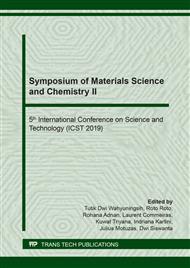[1]
Dewan Energi Nasional, Outlook Energi Indonesia 2015, Kementerian Energi dan Sumber Daya Mineral Republik Indonesia, Jakarta, (2016).
DOI: 10.21787/mp.3.2.2019.109-118
Google Scholar
[2]
W.C. Chen, Y.C. Lin, Y.L. Ciou, I-M. Chu, S.L. Tsai, J.C.W. Lan, Y.K. Chang, Y.H. Wei, Producing bioethanol from pretreated-wood dust by simultaneous saccharification and co-fermentation process, J. Taiwan Inst. Chem. Engrs. 79 (2017) 4348.
DOI: 10.1016/j.jtice.2017.04.025
Google Scholar
[3]
Direktorat Jenderal Hortikultura, Statistik produksi hortikultura 2014, Kementerian Pertanian, Jakarta, (2015).
Google Scholar
[4]
D. Irawati, Hydrolysis of the residual media of ear mushroom cultivation uses three types of cellulase enzymes, Jurnal Ilmu Kehutanan 11 (2017) 52–62.
Google Scholar
[5]
D. Irawati, Y. Takashima, C. Ueda, J.P.G. Sutapa, S.N. Marsoem, F. Ishiguri, K. Iizuka, N. Yoshizawa, S. Yokota, Ozone treatment of spent medium from Auricularia polytricha cultivation for enzymatic saccharification and subsequent ethanol production, J. Wood Sci. 59 (2013) 522–527.
DOI: 10.1007/s10086-013-1356-0
Google Scholar
[6]
C.N. Hamelinck, G.V. Hooijdonk, A.P.C. Faaij, Ethanol from lignocellulosic biomass: techno-economic performance in short, Middle, and Long-term, Biomass Bioenerg. 28 (2005) 384–410.
DOI: 10.1016/j.biombioe.2004.09.002
Google Scholar
[7]
V. Faraco, G. Palmieri, G. Festa, M. Monti, G. Sannia, P. Giardina. A new subfamily of fungal subtilases: structural and functional analysis of a Pleurotus ostreatus member, Microbiology 151 (2005) 457–466.
DOI: 10.1099/mic.0.27441-0
Google Scholar
[8]
M. Carrier, A.L. Serani, D. Denux, J.M. Lasnier, F.H. Pichavant, F. Cansell, C. Aymonier, Thermogravimetric analysis as a new method to determine the lignocellulosic composition of biomass, Biomass Bioenerg. 35 (2011) 298–307.
DOI: 10.1016/j.biombioe.2010.08.067
Google Scholar
[9]
D. Irawati, S. Yokota, T. Niwa, Y. Takashima, C. Ueda, F. Ishiguri, K. Iizuka, N. Yoshizawa. Enzymatic saccharification of spent wood-meal media made of 5 different tree species after cultivation of edible mushroom Auricularia polytricha, J Wood Sci. 58 (2012) 180-183.
DOI: 10.1007/s10086-011-1229-3
Google Scholar
[10]
A. Martawijaya, I. Kartasujana, K. Kadir, S.A. Prawira, Atlas kayu Indonesia jilid II, Pusat Penelitian dan Pengembangan Hasil Hutan, Bogor, (1989).
DOI: 10.1163/22941932-90001149
Google Scholar
[11]
N.N. Pradipta, The effect of incubation time and number of bag log credits on oyster mushroom productivity (Pleurotus ostreatus), Undergraduate Thesis, Fakultas Kehutanan UGM, Yogyakarta, (2016).
Google Scholar
[12]
D. Irawati, N.N. Pradipta, F. Margareta, J.P.G. Sutapa, Optimization of fruit body production for three types of wood fungus with innovation of treatment at incubation time and number of tears on Baglog, Jurnal Ilmu Kehutanan 13 (2019) 87–97.
Google Scholar
[13]
M. Haneef, L. Ceseracciu, C. Canale, I.S. Bayer, J.A. Heredia-Guerrero, A. Athanassiou, Advanced materials from fungal mycelium: fabrication and tuning of physical properties, Sci. Rep. 7 (2017) 41292.
DOI: 10.1038/srep41292
Google Scholar
[14]
M. Ballesteros, Enzymatic hydrolysis of lignocellulosic biomass, Bioalcohol Production 3 (2010) 159–177.
DOI: 10.1533/9781845699611.2.159
Google Scholar
[15]
C.K. Kuo, C.K. Lee, Enhancement of enzymatic saccharification of cellulose by cellulose dissolution pretreatments, Carbohydr. Polym. 77 (2009) 41–46.
DOI: 10.1016/j.carbpol.2008.12.003
Google Scholar
[16]
S. Adamopoulos, E. Voulgaridis, Effect of hot-water extractives on water sorption and dimensional changes of black locust wood, Wood Res. 57 (2012) 69–78.
Google Scholar
[17]
D. Irawati, N.R. Azwar, W. Syafii, I.M. Artika, Utilization of sawdust for ethanol production by preliminary treatment of delignification using mushrooms Phanerochaete chrysosporium, Jurnal Ilmu Kehutanan 3 (2009) 13–22.
Google Scholar
[18]
H. Zabed, G. Faruq, J.N. Sahu, M.S. Azirun, R. Hashim, A.N. Boyce, Bioethanol production from fermentable sugar juice, Sci. World J. 2014 (2014) 1–11.
DOI: 10.1155/2014/957102
Google Scholar
[19]
Y. Tang, D. Zhao, C. Cristhian, J. Jiang, Simultaneous saccharification and cofermentation of lignocellulosic residues from commercial furfural production and corn kernels using different nutrient media, Biotechnol. Biofuels 4 (2011) 22.
DOI: 10.1186/1754-6834-4-22
Google Scholar



